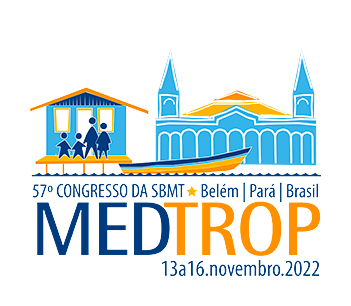Dados do Trabalho
Título
INFECTIVITY AND VIRULENCE FOR BALB/C MICE OF THE COLOMBIAN STRAIN OF TRYPANOSOMA CRUZI I INOCULATED BY DIFFERENT ROUTES
Introdução
Outbreaks of acute Chagas disease acquired by oral route have been frequently reported over the last decades in some regions of South America countries where T. cruzi I (TcI) prevail. However, in the majority of experimental studies the mice are inoculated by intraperitoneal route.
Objetivo(s)
The aim of this work was to analyze comparatively the infectivity and virulence of the Colombian strain of T. cruzi for mice inoculated by OR, intragastric (IG) and intraperitoneal (IP) routes.
Material e Métodos
Male, isogenic BALB/c mice, 21 and 28 days and 18 to 20 g were divided into three experimental groups of 10 animals each, according to the inoculation route. The animals received 1x106 culture-derived metacyclic trypomastigotes (CMT) from the Colombian strain (TcI) in 0.1 mL of LIT medium. The infectivity rate and the parasitemia was daily determined by fresh blood examination (FBE) from the 5th day of infection (d.i.). The means for pre-patent period (PPP), patent period (PP), maximum peak parasitemia (Pmax), day of maximum peak (Dpmax) and area under the parasitemia curve (AUC) were obtained.
Resultados e Conclusão
The percentage of animals with positive FBE was 100% and the mortality rate was 0% for the three groups. We observed oscillating and long-term parasitemia profiles (up to 90 d.i.), an earlier Dpmax (at 19 d.i.) in animals inoculated by the IG and OR routes than in animals IP inoculated (at 48 d.i.), and lower levels of parasitemia in animals inoculated by the IG route. Statistical comparisons of the means showed significant differences between the three groups for PPP (11.7, 16.2 and 10.3 days - p<0.0001), PP (61.8, 45.2 and 68.2 days - p<0.0269) respectively for OR, IG and IP groups, and AUC (p<0.0001). The Pmax were 8,910 (OR), 8,190 (IG) and 17,183 (IP) blood trypomastigotes/0,1 ml of blood, without statistical differences. Based on these results obtained we can conclude that the infection by the IP route was more virulent, with earlier parasitemia and longer PP in relation to the OR and IG routes. Although the TcI strain infected all animals by the three different routes (OR, IG and IP), parasitemia levels were low, ranging from 8,190 (IG) to 17,183 (IP) BT/0.1 ml, and the letality was null. The low virulence for BALB/c mice of the CMT from Colombian strain (TcI) has been confirmed by histopathological and immunomodulatory analyzes of these animals that are in progress.
Apoio: Capes, PROAP
Palavras-chave
Key-words: Oral Chagas disease, TcI, mice, parasitemia.
Área
Eixo 06 | Protozooses
Categoria
(Concorra com apenas um trabalho) Concorrer ao Prêmio Jovem Pesquisador - Mestrado
Autores
Giullia Ferreira Iunklaus, João Vitor Souza Trovo, Max Jean de Ornelas Toledo, Taís Protzek Ferreira
